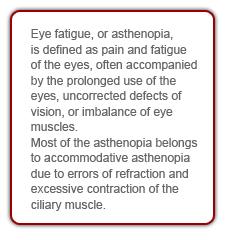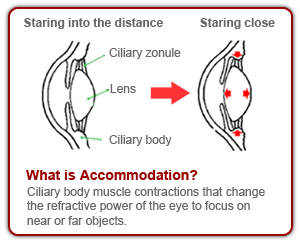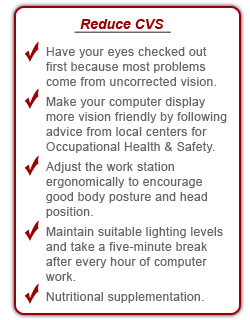|
|
|
Find out If You Have Computer Vision Syndrome |
| Greetings!
 Do you use computers or handheld devices on a daily basis for a significant amount of time?
Do you experience any of the following eye discomfort symptoms such as burning, dryness, photophobia, irritations, itching, blurring, double vision, tearing, and sensation of a foreign body?
Do you experience neck ache, backache, and fatigue?
If you answered "yes" to all the above questions, then you are likely to have Computer Vision Syndrome (CVS). In this newsletter we talk about how supplementation with AstaREAL® Natural Astaxanthin can help with internal asthenopia in CVS. |
|
|
Computer Vision Syndrome
 This is a complex of eye-fatigue (Asthenopia) and vision problems related to computer work because reading Visual Display Terminals (VDT) affects the eye muscles more than reading print material. Furthermore, CVS is linked to muscle strains commonly affect the neck and back.
Currently, the awareness of CVS as a source of worker discomfort and decreased performance is relatively low. Most people accept it because CVS is not life threatening. However, the quality of life at work or home will be affected because symptoms accumulate. It is important to remember that it takes a long time for symptoms to develop and equally as long for recovery.
 The widespread use of computers has exposed adults to CVS more than ever before. Furthermore, there appears to be neither geographical nor age restriction to the vulnerability to CVS. Surveys on populations in USA, Japan, Italy and India have shown asthenopia to be significantly higher in computer users and the severity can vary depending on the type of visual work, whether usage began at an early age, and number of years of exposure. What that means is that even children who begin to use hand-held game devices at an early age are thought to be more at risk in developing CVS. If the problem is not sufficiently addressed, the number of CVS sufferers will continue to rise. |
Asthenopia - Is it external or internal?
 Asthenopia is derived from the Greek word meaning "weak eye". For regular people, it is eye-fatigue or eye-strain. Intense visual focus from reading, computer work, and even long distance driving will cause asthenopia. External asthenopia tends to be dry eye and corneal irritation related whereas internal asthenopia are related to muscles associated with binocular alignment and accommodation.
|
What can be done about CVS?
 It's best to seek advice from an eye specialist and determine if the problem is CVS related and then decide the appropriate course of action. On top of that, adjust computer usage habits and develop a style that manages asthenopia. It is important to allow the eye muscles to recover because fatigue builds up and turns into accommodation dysfunction. This is where nutritional treatment can help. In the past, Age-Related Eye Disease Study (AREDS I) showed that Vitamin C and E, beta-carotene and zinc can reduce the risk of developing Age-related Macular Degeneration (AMD). Carotenoids such as lutein and zeaxanthin may protect against cataracts and AMD as well. Therefore, it is not hard to believe that natural astaxanthin may also have a positive effect in the eye. Nine independent clinical studies reported that natural astaxanthin protected the ciliary body muscle against accommodation dysfunction, improved blood flow and critical flicker fusion. Eight out of those nine studies were randomized, double-blind and placebo controlled. Therefore, it is possible that natural astaxanthin can help defend against CVS.
|
| Accommodation Dysfunction
Accommodation dysfunction is when the eye develops the inability to focus on objects at different distances. Seven clinical studies examined the visual effects of natural astaxanthin on accommodation. The result was interesting because not only did 4 week supplementation significantly improve objective accommodation measurements in CVS sufferers, but also accommodation recovery in people without CVS. |
Improve eye-discomfort, neck and shoulders
Subject questionnaires devised by ophthalmologists revealed a strong tendency to improve overall muscle condition. Nagaki (2006; 2002) reported significant improvement of eye discomfort, heavy head, bleary eyes and stiff shoulders and back.
|
Outlook:
CVS affects people more than they realize and avoiding CVS is difficult when work involves computer usage. Seek sensible advice from specialists and replace old habits with new ones that avoid eye-fatigue. On top of that, taking care of eye-fatigue with natural astaxanthin may offer additional help. |
Summary of Natural Astaxanthin Intake against CVS
Visit www.astareal.com for more details on the results.
Improves eye-fatigue (accommodation) in CVS subjects.
Nagaki et al., (2006). The supplementation effect of astaxanthin on accommodation and asthenopia. J. Clin. Therap. Med., 22(1):41-54.
Nitta et al. (2005). Effects of astaxanthin on accommodation and asthenopia-Dose finding study in healthy volunteers. J. Clin. Therap. Med., 21(6):637-650.
Shiratori et al. (2005). Effect of astaxanthin on accommodation and asthenopia- Efficacy identification study in healthy volunteers. J. Clin. Therap. Med., 21(5):543-556.
Nakamura et al. (2004). Changes in Visual Function Following Peroral Astaxanthin. Japan J. Clin. Opthal., 58(6):1051-1054.
Nagaki Y., et al., (2002). Effects of astaxanthin on accommodation, critical flicker fusions, and pattern evoked potential in visual display terminal workers. J. Trad. Med., 19(5):170-173.
Protected against eye-fatigue (accommodation) and improved recovery for non-CVS subjects.
Iwasaki & Tawara, (2006). Effects of Astaxanthin on Eyestrain Induced by Accommodative Dysfunction. Atarashii Ganka (6):829-834.
Takahashi & Kajita (2005). Effects of astaxanthin on accommodative recovery. J. Clin. Therap. Med., 21(4):431-436. [Open-label study]
Other improved eye-function in normal subjects such as retinal blood flow, critical flicker fusion, and visual acuity.
Nagaki et al. (2005). The effects of astaxanthin on retinal capillary blood flow in normal volunteers. J. Clin. Therap. Med., 21(5):537-542.
Sawaki, K. et al. (2002) Sports performance benefits from taking natural astaxanthin characterized by visual activity and muscle fatigue improvements in humans. J. Clin. Ther. Med., 18(9):73-88.
Suggested reading
Fukuda et al., 2008. Intraocular penetration of astaxanthin in rabbit eyes. Atarashii Gankai, 25(10):1461-1464.
Suzuki et al., (2006). Suppressive effects of astaxanthin against rat endotoxin-induced uveitis by inhibiting the NF-kB signalling pathway. Exp. Eye Res., 82:275-281.
Miyawaki et al., (2005). Effects of astaxanthin on human blood rheology. J. Clin. Therap. Med., 21(4):421-429.
Ohgami et al., (2003). Effects of astaxanthin on lipopolysaccharide-induced inflammation in vitro and in vivo. Invest. Ophthal. Vis. Sci., 44(6):2694-2701. | |
 AstaREAL is a trademark or registered trademark of Fuji Chemical Industry Co., Ltd in Japan, United States of America, Europe and/or other countries. AstaREAL is a trademark or registered trademark of Fuji Chemical Industry Co., Ltd in Japan, United States of America, Europe and/or other countries.
|
To obtain a sample or to find your local distributor, please contact us.
To read Fuji's newsletter back numbers, click here | |
To ensure to receive this newsletter in your inbox, please add
|
|
The information found in this publication is presented in good faith with no guarantee or obligation as to accuracy and no assumption of liability. Users should make their own tests to determine the suitability of these products for their own particular purposes. However, because of numerous factors affecting results, Fuji Chemical Industry makes no warranty of any kind, express or implied, including those of merchantability and fitness for particular purpose other than the material conforms to its applicable current standard specifications. Statements concerning the use of the products or formulations described herein are not to be construed as recommending the infringement of any patent and seller assumes no liability for the infringement arising out of such use. |
© 2009 - Fuji Chemical Industry Co., Ltd. - All Rights Reserved
| |
|
|
|
|